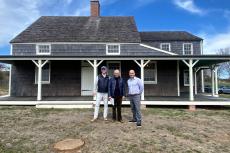The New York Housing Compact, Gov. Kathy Hochul’s plan to address a housing shortage by building 800,000 new residences over the next decade, is a heavy-handed approach that would be wholly incompatible with East Hampton Town, possibly resulting in no less than “the death of our community,” the town’s planning director told the town board on Tuesday.
The plan, announced as part of the governor’s fiscal year 2024 executive budget, has since been “spun off as standalone legislation,” Jeremy Samuelson told the board, but if enacted, it “is really going to have a far-reaching effect,” he said.
For example, Morgan Slater of the Planning Department told the board, the compact mandates a 3-percent increase in housing for regions that have access to public transportation operated by the Metropolitan Transportation Authority — such as the Long Island Rail Road — translating to around 600 new housing units constructed in the town within three years. If the town did not meet that mandate, it would have to enact a “pick your poison” approach, choosing two of five “preferred actions” that would effectively obliterate the town’s zoning code.
One of these is the allowance of accessory dwelling units of up to 1,500 square feet with four-foot setbacks, no minimum lot size, maximum coverage, or parking requirements, and no updated certificate of occupancy requirement. Another would allow for lot splits and lot-line modifications with no explicit size requirement other than being able to accommodate an 800-square-foot residence with four-foot side and rear-yard setbacks. Another would remove lot size requirements and height and coverage restrictions.
Two other options would permit construction of 25 units per acre on previously developed land equal to a third of the total disturbed land in the town, or in an area that was previously only allowed for commercial space. Mandating any of these actions is all but certain to dramatically increase density.
Should the town still not meet the mandate, it would have to approve any application considered a qualifying project — defined as at least 20 units where 20 to 25 percent are affordable — within 120 days, Ms. Slater said. Review of applications would be limited to determining the ability to provide water, septic, and utilities. If such a project were denied, the applicant could appeal to the state, which “can essentially overrule our zoning laws and approve the application anyway,” she said.
It’s an “all sticks and no carrots” approach to solving the housing crisis, Ms. Slater said. “There’s also not much in the legislation that requires new housing to be affordable.” It “effectively eliminates home rule and decades of work put into creating our own local zoning, building, and environmental regulations.”
Much progress has been made on how the public views affordable housing, she said, “and if passed as it is written, it will completely undermine” existing affordable housing efforts “and the door will be open to developers to build high-density luxury housing.”
But there has been pushback “on even the core assumptions of this proposal, and the general approach,” Mr. Samuelson said. In the Hudson Valley, where a 3-percent increase in housing would also be mandated, communities have coalesced to speak with one voice in opposition. “Others on Long Island have begun similar conversations,” he said.
Fortunately, he added, Assemblyman Fred W. Thiele Jr. has introduced incentive-based alternative proposals, the centerpiece being $500 million of new direct aid for the creation of local housing plans. Municipalities would apply to the program, with 30 percent of requested money allocated by the state to commence proposals deemed viable, the balance awarded upon completion.
“It is thinking that happens in concert and in partnership with the state,” he said, “but it is done with the values and goals and aspirations of the local community in the plan that they put forward.”
Mr. Thiele’s proposal also includes special consideration for affordability, and the growth target — 800,000 units — would be very similar to those of the governor’s plan, he said. “This conversation is ongoing, and the governor has staked out a position on one extreme. I think there’s beginning to emerge something I’ll describe as a cooler set of heads that are prevailing here in terms of what a more reasonable approach looks like.”
The town’s ceding the ability to establish its own density, coverage, setback limitations, and environmental regulations “is a dangerous precedent,” Mr. Samuelson said. “I’m frankly dumbfounded that we’ve gotten here.”
The town should craft a formal comment letter to the governor “that offers some insight and some detail about why we find this to be such a frustrating set of proposals,” he said, “but also trying to speak in the affirmative about what we think some better solutions can be here.” The town should work with like-minded towns and villages to seek redress with one voice. The town should also continue working with Mr. Thiele and State Senator Anthony Palumbo “to deliver effective housing legislation, funding, and incentives.” All the while, Mr. Samuelson said, the town should continue the All Hands on Housing initiative launched last year.
Should the Housing Compact be enacted as envisioned, some 600 units — 3 percent of the town’s existing total — could be constructed without a single affordable house or apartment added, he said, “and that could actually count as fulfilling the requirements under the governor’s proposal.”
“You’ve effectively confirmed all my concerns,” Supervisor Peter Van Scoyoc said. “Many of these proposals might look good on paper, and they might look good somewhere else, but they certainly do not fit here whatsoever. . . . We don’t need more market-rate housing here. I think we’re the poster child for no more market-rate housing, and maybe some not-market-rate housing to balance things out, because no one who works within this market can afford to live in this market anymore. I think that’s a fair statement to make.”




